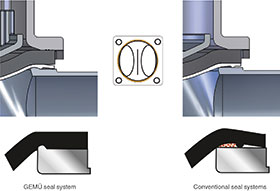

GMP is not a standard
Contrary to common belief, Good Manufacturing Practice is not an independent quality management system (QA) for pharmaceuticals, but a regulatory code for manufacturing processes in pharmaceutical plants and for checking the products manufactured within them. Pharmaceutical companies, which manufacture to GMP standards, are obliged to incorporate GMP in their existing QA system. This applies, in particular, where they intend to market their products worldwide.
Pioneer in the field of GMP
As a manufacturer of important components, such as valves, for production plants that manufacture medicines, GEMÜ is committed to the ideas and basic principles of GMP. Valves produced by GEMÜ have gained a reputation, particularly in the area of sterile applications in biotechnology plants. One of the reasons for this is that the company has worked continuously on the implementation of GMP requirements in its products for over 50 years. GEMÜ valves are among the top products available, especially when hygiene and sterility are essential requirements.
Dirt in focus
Many products are developed with a focus on sterility or hygiene. Because GEMÜ always considers the problems of germs and caking right from the start of its product development process, the company has developed valves for biotechnology, which set the standard with respect to GMP requirements.
A simple example illustrates the approach. The undetected entry contamination with extraneous germs generally has fatal consequences for biotechnology processes. Inevitably, they overrun the inoculated target culture and destroy entire fermentation batches extremely quickly along with large quantities of expensive culture media – without any opportunity for intervention. These germs not only ruin weeks or months of work, they also cause immense financial damage and even delivery shortages of the finished medicine in question. Contamination of this nature with extraneous germs is the worst possible event for anyone involved in biotechnology plants.
When developing valves for biotechnology, GEMÜ decided that it first needed to understand 'dirt' i.e. extraneous germs, biofilms, fouling and deposits. In particular, how they get into production plants for biotechnology and where they linger.
The scientists and engineers at GEMÜ thus start by carefully investigating extraneous germs to determine their behaviour and their ability to survive in the components of biotechnology plants. Knowledge of the survival strategies and niches of extraneous germs is thus the true starting point for the unique valve solutions, which fulfil the stringent requirement of being GMP-compliant in every respect. This means that the valves are always designed so that they offer no hiding places. Accordingly, they can be sterilised easily, often under milder conditions. They also counteract hard deposits very effectively, which also helps to make cleaning quick and uncomplicated.
Looking at the inside of the diaphragm valves, the most common type used in biotechnology, the important differentiating characteristics show how they are designed to deter extraneous germs and prevent hard deposits.
Most manufacturers of diaphragm valves equip their diaphragms with a sealing lip, which seals the body against its environment. This design feature inevitably results in a recess and a gap where the liquid medium can enter and then work its way into the cavity behind – an ideal hiding place for unwanted germs and caking.
Even worse is the ‘pump effect’, which can occur when diaphragm valves of this type are actuated. Each time the diaphragm closes, the liquid located in this cavity – which actually represents nothing more than unwanted dead volume – is pumped back into the fluid flow. The consequences are clear: a high risk of bringing extraneous germs from this dead volume into the process and a constant hazard of cross-contamination if deposits from the dead volume get back into the fluid flow. It is obvious that plants using this type of valve take much longer to clean and sterilise, and the conditions under which this is carried out need to be a lot stricter.
As described previously, GEMÜ follows a design philosophy, which although it may appear complicated and difficult at first glance, virtually ‘immunises’ the diaphragm valve against hazardous penetration of germs, unwanted hard deposits and contamination.
In contrast to many other manufacturers, the sealing lip on GEMÜ valves is not on the diaphragm itself, but is instead machined or cast on the valve body. This unique technology keeps the diaphragm flat over its pressed surface, which is exactly why fluid cannot get behind it – the result being the lack of dead volume of GEMÜ diaphragm valves. Consequently, the possibility of the undesirable ‘pump effect’ is ruled out.
The European Hygienic Engineering & Design Group (EHEDG) has tested and approved the sealing system of GEMÜ diaphragm valves.
For more information contact Claudio Darpin, GEMÜ Valves Africa, +27 (0)11 462 7795, [email protected], www.gemue.co.za

© Technews Publishing (Pty) Ltd | All Rights Reserved